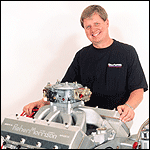By David Reher, Reher-Morrison Racing Engines
“The pressure curves explained what I’ve learned about racing engines through years of experience and observation.”
Unless your race car is powered by a jet engine or a turbine, a critical factor in engine performance is the pressure exerted on the pistons. The goal in race engine development is to maximize the cylinder pressure that pushes against the pistons and thereby rotates the crankshaft.
But have you ever thought about how that pressure is applied in the real world?
Several years ago, I had an opportunity to find out what actually happens inside a cylinder. We were working with GM on Pro Stock engine development, and an engineer showed up at our shop with a device to measure cylinder pressure inside a running engine.
As you would expect, a transducer that can survive the heat and strain of a Pro Stock big-block running at 10,000 rpm is a rather sophisticated (and expensive) piece of hardware. We modified a cylinder head to allow a sensor to be inserted into the combustion chamber, where it relayed data on cylinder pressure to a computer. The computer’s software then plotted a curve of cylinder pressure versus crankshaft position. What we saw was very instructive.
I expected that cylinder pressure would rise and fall smoothly as the fuel burned. What the transducer showed was very different: The pressure spiked upward to a sharp peak, and then dropped rapidly. When the fuel-air mixture ignited, the cylinder pressure rose in a nearly vertical line – and then it fell just as quickly. All of this happened within five or six degrees of crankshaft rotation. A big bang . . . and then nothing.
At this point I should point out the important difference between the actual cylinder pressure that we measured and the theoretical Brake Mean Effective Pressure (BMEP). BMEP is a calculation used by engineers and engine builders to compare the relative performance of different engines. It is the average (mean) pressure that would produce the engine’s measured output if the pressure on the pistons was uniform throughout the power stroke – which it obviously is not in the real world.
The engineer also had been testing a small-displacement turbocharged engine, and he shared its pressure graphs with me. The trace was strikingly different from our naturally aspirated engine. In the turbo engine, cylinder pressure rose relatively slowly, maintained a steady plateau for about 30 degrees of crankshaft rotation, and then fell gradually. The peak reading wasn’t as high as our naturally aspirated engine, but the duration was five or six times longer. In effect, the force of the cylinder pressure was pushing against the piston for a much longer interval. It’s no wonder that turbocharged and supercharged engines make so much power!
The pressure curves explained what I’ve learned about racing engines through years of firsthand experience and observation. We worked on a customer’s turbocharged, methanol-burning Toyota engine that produced 2058 horsepower from 189 cubic inches. For those of you keeping score, that’s almost 11 horsepower per cubic inch with a production block and cylinder! We filled the cast-iron block and aluminum head with high-pressure grout, machined billet main caps, and increased the diameter of the head studs to withstand the pressure that this engine was capable of producing.
Induction pressure definitely makes a difference. In a naturally aspirated engine, the force that fills the cylinders is the differential between atmospheric pressure (approximately 14.7 pounds per square inch at sea level) and the lower pressure inside the cylinders. When these pressures equalize, cylinder filling stops. Bolt a turbocharger (or supercharger) onto the engine and now there are three or four atmospheres of pressure in the induction system to fill the cylinders. In the example of the Toyota turbo engine, we had 60 psi pressure to ram air and fuel into the cylinders.
Even with sky-high cylinder pressure, the parts always looked perfect whenever we overhauled that engine. In fact, forced induction engines can be very durable, providing the components are designed to withstand the engine’s output and the fuel/air mixture and the spark timing are correct. The fact that there is always pressure in the cylinder, even during the overlap period when the intake and exhaust valves are open simultaneously, works as a cushion that keeps the piston/pin/rod assembly under constant compression. A normally aspirated engine can be harder on parts because the piston assembly is unloaded during the overlap period, allowing the rods to stretch and varying the loads on the pins and bearings.
I haven’t seen a cylinder pressure curve from a nitrous-injected Pro Mod motor, but I’m certain that the pressure spike is short and vicious. We typically set the spark timing in a nitrous Pro Mod motor at 5 or 6 degrees before Top Dead Center because nitrous oxide is such a powerful oxidizer that the fuel burns extremely fast, reducing the need for more than a few degrees of spark advance.
I’ve seen what the cylinder pressure in a nitrous-injected Pro Mod motor can do, and it’s amazing – flattened wrist pins and connecting rod bores knocked out of round. It takes some serious hardware to stand up to the forces in a Pro Mod engine. We’re not running Top Fuel parts yet, but we’re getting closer.
So whether an engine is competing in Bracket 5, Pro Stock, or Pro Mod, performance is ultimately all about cylinder pressure.

